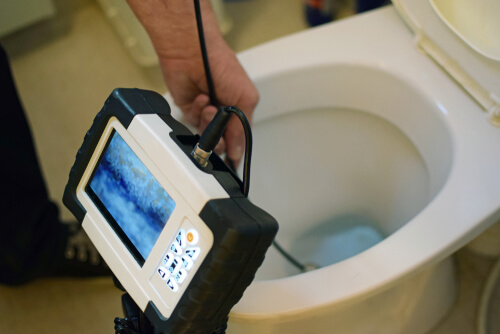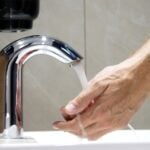
How Do Plumbers Clean Drains – The Tools and Techniques You Need to Know
- By: Amer ZaghloulehUncategorizedComment: 0
Many of us may not think about drainage until a blocked pipe causes a major issue. Clogged drains are one of the most frequent plumbing problems at home. When a plunger or vinegar doesn’t cut it, it’s probably best to call a plumber. But have you ever wondered how plumbers clean out drains?
This article covers all you need to know about how plumbers professionally clean drains and the tools and techniques used.
Drain Cleaning Tools
A plumber will use a drain auger or a drain snake to clean out drains efficiently. Plumbing augers are a family of tools sometimes called “snakes.” They are designed to break up clogs using different motions inside the pipework. They can be powered by electricity, connected to a drill, or operated manually.
Drain Auger
A drain auger is a basic tool traditionally used externally for opening outside clogged sewer drains. Its long hose is suitable for pipes ranging from 1.5 to 3-inches wide. Drain augers are comparable to drain snakes in function and equally straightforward to maneuver by twisting the hose to clean the more challenging-to-reach places.
Some drain augers, like the bulb drain auger, have different attachments and tips to suit other purposes and scenarios.
Drain Snake
A drain snake, sometimes known as a plumbing snake, is the best way to clean pipes in house and get rid of stubborn drain clogs that a regular plunger can’t loosen. Usually, the drain snake is not as broad as the drain auger. It’s slender and flexible. A drain snake often has helix-shaped hooks with a large gap between its coils.
Here are typical examples of manual and motorized drain-cleaning tools.

Cable Augers
Cable augers are the most straightforward drain-cleaning tool. It is a flexible rod with a corkscrew attached at the end and has a crank or handle.
The crank should be rotated manually to force the rod into the blocked pipe. As the rod rotates, it will attempt to grasp the blockage. You’ll have the option to keep pushing to allow the rod to penetrate the clog or pull it out.
Toilet Closet Augers
A toilet auger, sometimes referred to as a closet auger, is specifically designed to clean clogged toilet bowls. These types can be an electric auger connected to a power drill or a hand-cranked manual cable.
While the device is much the same as the cable auger, this version is relatively short and features a long, metal rod with a bend J-like shape for easier navigation through a toilet’s drain line. Although most augers are engineered from metal, this type may feature a plastic cap on the end. The cap end is inserted into the toilet to protect the porcelain from scratches or chips during use.
It’s constructed this way to reach deep inside your toilet system, way beyond the base of the toilet bowl, and its design is probably the most resourceful available. The auger cable is strung through the auger and into the blockage to break down a clog.
A Specialized Flange Plunger
Another tool to help remove toilet blockages is the specialized flange plunger. Although this type may look like an ordinary plunger, it is far from the standard familiar one.
It is precisely shaped to help clear challenging toilet clogs. It’s shaped like a typical plunger but has an extra rubber flap affixed to the top of the head called the flange. The flange flap seals around the whole toilet bowl, giving additional hydraulic pressure ideal for removing larger clogs.
Drum Augers
Drum augers have a prominent rod storage feature and are also referred to as sink or canister augers.
The drum auger comprises a malleable stainless steel cable with a corkscrew-style tip. The line is coiled inside the drum canister. This way, the rod is kept neat and is more manageable, preventing it from tangling or kinking. A drum auger commonly holds a rod of 50 inches, thanks to the drum container.
Depending on a drum auger’s size and cable length, it can be just the proper tool for clearing clogs in the bathtub, sink drains, drain pipe, and toilets. A small rod with a diameter of 1/4 inch can be used for household water systems like sinks and showers, while external drains can be cleaned using a larger rod of 5/6 inches or more in diameter.
Much like the cable auger, the cable of a drum auger reaches deep inside the drain to pierce the stubborn clog and break it up before removal. The thumbscrew helps lock the line inside the auger, so you can rotate the handle to turn the cable as it curves through the bends of your pipe work.
Flat Tape Augers
The flat tape auger is similarly designed to the cable auger, but the rod is replaced with a flat cable. This type is helpful to clean drains with a smaller pipe diameter of 2 inches or less. Some flat tape augers push blockages through the pipe with their spearpoint tip. Its cable is less flexible than a round wire but more robust.
The flat tape auger is ideal for resolving stubborn obstructions inside a drain. It’s generally best for wash basins and sinks.
Motorized Augers
Powered augers can be used when a manually-operated auger isn’t enough and a more powerful clog-removal action is necessary.
Motorized augers include built-in motors, so there’s no need to turn, crank, or twist the rod—the electric auger drills into the clogged center in a corkscrew-like motion. It removes an obstruction by lodging its end inside the blockage, then breaking it apart before drawing it out of the pipe.
When a motorized auger is used correctly, no clog is safe as the rod can spin at faster revolutions for the best chance of getting the entire blockage. There aren’t many types of blockages that it can’t smash its way through.
Rocket Nozzle Augers
The rocket nozzle auger is the most powerful drain-cleaning tool. It’s considered a small tube that inserts into drains instead of a cable and the best way to clean a drain.
Again, due to the motor, no twists, turns, or rod rotation is required. The tube blasts high-pressurized water at the blockage to disintegrate the most stubborn obstructions, including tree roots. This tool removes clogs and helps remove hard water minerals and deposits.
Plumbing professionals use rocket nozzle augers, sometimes referred to as a hydro-jet or a water jet. It can unclog large pipes up to 10 inches in diameter.
Tips to Help Keep Your Drains Clear
The common culprits of a clogged drain tend to be cooking grease, hair, coffee grounds, and soap scum. There are several ways to dispose of common drain-clogging materials other than the sink. For example, cooking grease can be saved in a coffee can before throwing into the trash. A drain grate or screen can catch hair in the shower and stop soap scum from draining.

Here are some other tips to consider in helping to keep your drains clog-free.
- Fit strainers in the kitchen sink. The filter will ensure only liquids enter the drains by catching food and other particles.
- Pour a cup of vinegar down the drain. Vinegar is an organic cleaner, and its acetic acid content can remove a minor buildup of oils and foods.
- Use hot water to rinse kitchen drains. Hot water helps the oil in food products run down the drains more easily.
- Throw some baking soda into the drain. The versatility of baking soda also extends to a great cleaning agent. It will absorb nasty odors and ensure your sinks remain smelling fresh and clean.
How to Tell That Your Drains Need Cleaning
If your home drainage system needs cleaning, you’ll likely notice one or more of the following symptoms:
- Your toilet frequently overflows. If your toilet clogs or overflows often, it could be a sewer line problem. In this scenario, you’ll need to arrange for a professional plumber to investigate.
- Slow drainage. If the water takes ages to go down the pipes, or you hear a gurgling sound as it drains, there could be a blockage in your pipes.
- Bad smell. If you notice your kitchen drains give off a foul odor, it could mean that grease or food particles are causing a blockage.
- Water backing up. Water from the drain filling up your tub or sink signifies a clogged pipe or sewer line, which can be unsanitary and cause expensive water damage if ignored.
How to Clean Drainage
If you believe your drains are experiencing a minor clog, you’ll likely want to know what you can do yourself. Check out what to use to clean drains and resolve common clogs inside your home.
- Use a plunger, manual drain snake, or a sink full of hot water to clean sink and bathtub drains.
- Use a plunger or manual drain snake, or call a professional for toilet drainage issues.
- Use running hot water, baking soda, vinegar, or a grease-fighting liquid agent to clean out drains in the kitchen.
How to Clean Drains Using a Drain Auger
Follow these steps when using a manual drain auger to clean drains or unclog your toilet or drain:
- Insert the end of the auger directly into your toilet or drain.
- Rotate the handle as you slowly push the tool into the toilet or drain. Keep rotating until you find the clog. When an object is encountered, the auger will attempt to snag it.
- Once the blockage has been found, remove it without rotating the auger.
Repeat these steps until your drain or toilet is unclogged.
How Not to Clean Drains
Most professional plumbers strongly advise against using chemical drain cleaner on your drainage pipes. Using a plunger or drain snake is the best way to clean pipes in the house.
Although super convenient, chemical drain cleaners are more troublesome than their worth. Some brands are corrosive due to their acid content. When these chemicals react with aluminum, they solidify inside the pipework and cannot be removed. In addition, they are very toxic and can give off poisonous fumes, contaminate the water, and pollute the landfill.
Additionally, crystal chemical drain cleaning products are hazardous and can ruin your septic system, garbage disposal, and pipes. Gel cleaners and liquid foam can also cause damage and aren’t particularly effective. They take at least 30 minutes to eat through a clog and may dissolve a part of the blockage but not complete the job.
Professional Plumbers Offer the Best Way to Clean a Drain
Manual auger tools are best for clearing minor clogs yourself. However, in addition to having the equipment required to clean major and external clogs, plumbers can detect where a clog is and whether it’s been cleared completely.
Video Pipe Inspection
An experienced plumber can perform a video pipe inspection to identify significant obstructions in your pipework to help speed up the cleaning process. The plumber inserts a miniature camera into the drains for a thorough inspection. Optimal drainage viewing is achieved by mounting a camera to a fiber optic cable threaded throughout the system.
A video inspection can help outline the extent of a clog so that the plumber can decide what tool to use for the best way to clean a drain efficiently. The plumber can then perform a subsequent inspection to establish whether their cleaning method has been effective.

Plumbers Can Give Your Drainage a Thorough Clean
Due to the amount of stuff that ends up down our drains daily with and without our knowledge, it’s no wonder drain pipe blockages are common. If you think your drains could have a minor clog, in most cases, some hot water, a plunger, or a manual drain snake tool should clear it.
However, you won’t be able to tell whether your cleaning has entirely resolved the issue. Contacting a professional plumbing service like Anytime Plumbing to investigate and clean your drains can prevent a clog from developing into a messy and expensive problem.







